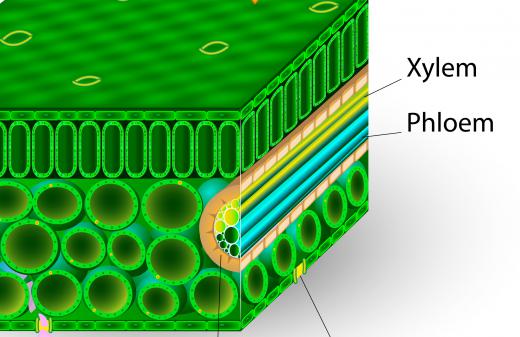What is Phloem?
Phloem is a type of tissue found in plants. Along with xylem, phloem makes up the transport system within plants. Phloem and xylem are completely separate within the transport system. Both tissues are found throughout plants and each carries different substances to and from different parts of the plant. Phloem is used to transport dissolved substances, sap, around the plant, while xylem transports water.
The transport system of plants differs from that of mammals in two distinct ways. Plant cells do not need substances as quickly as mammals because they are a lot less active. Water and dissolved substances move throughout the plant by diffusion and osmosis, they are not driven by a pump, like the heart. The other difference is in what is carried in the tissues of the transport system and where.

In mammals, blood is carried throughout the transport system with arteries carrying blood away from the heart and veins carrying it back. In plants, substances and water move in all directions, up and down and to and from leaves. Also, the phloem and xylem have completely different transport jobs, one carries water and the other food. Through the phloem tissue, sugars made in the leaves during photosynthesis are carried to all other parts of the plants to be used in cell functions, growth or for storage in the roots.
Phloem, and xylem, tissue is arranged so that cells join end to end to form long tubes throughout the plant. The cells that make up the transport system have been modified to allow easier transport through the plant. In xylem tissue, the cells are dead. The end cell walls are completely broken down to make a hollow tube allowing fast transport of water and also providing support to the plant. Phloem cells are not dead and only provide a transport role; they are not used as support as well.
Phloem tissue is made up to two different types of cells, each with very specific roles. The actual tube where the sap flows is called the sieve tube and it is made up of sieve tube elements. The cell walls, or sieve plates, of these cells are not completely broken down like in xylem, but have tiny pores, or holes, in them. The pores allow the dissolved nutrients to move easily through the tube. Unlike most living cells, sieve tube elements do not have a nucleus and only have a very thin layer of cytoplasm with very few organelles.
The other cells that make up phloem tissue are called companion cells. Due to the lack of a nucleus and organelles in the sieve tube elements, it would be very difficult for them to live on their own. For each sieve tube element, there is a corresponding companion cell that contains a nucleus, organelles and very dense cytoplasm full of nutrients. The companion cells carry out the living functions for both itself and its sieve tube element. These two cells are actually formed from a single cell during the development of the phloem tissue.
AS FEATURED ON:
AS FEATURED ON:











Discussion Comments
The only thing that strikes me as odd is that the phloem transports sap through out a plant. I didn't realize that plants had sap in them. I thought only trees did. Do all plants have sap, or just certain kinds? And if there is a plant that does not have sap in it, does it still have phloem?
This is so hard for me to wrap my brain around! I just never pictured plants to have fluid moving around inside them. I know this doesn't make much sense -- I know plants need water to live -- but I just never thought of them as having a whole fluid transport system, like people do.
It's crazy how much actually goes on inside a little plant!
Post your comments